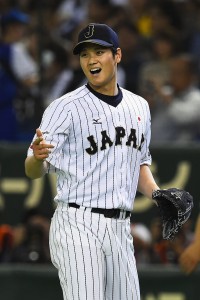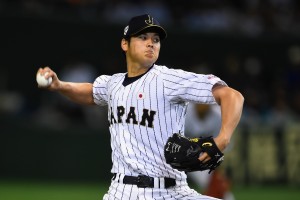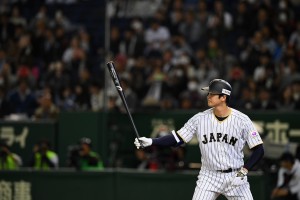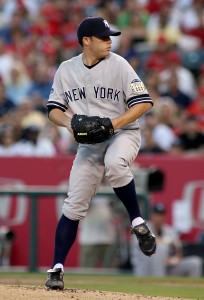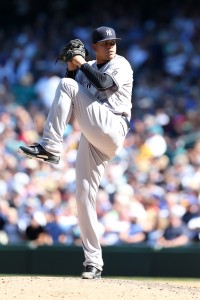This article by Chuck Wasserstrom was originally published in 2017. For all the entries in Chuck’s Inside the Draft Room series for MLBTR, click here.
The way things are shaping up, the 2009 Los Angeles Angels of Anaheim draft would have to be considered a good one even if the 25th pick belonged to somebody else. When three starting pitchers (including two southpaws) and a power-hitting position player reach and produce at the major league level, it makes for a nice haul.
The team’s first selection, Randal Grichuk, is now a starting outfielder for the Cardinals – and is coming off a 24-homer season as a 24-year-old.
Supplemental first-rounders Tyler Skaggs and Garrett Richards were members of the Angels’ season-opening starting rotation. Second-round pick Patrick Corbin is the Diamondbacks’ No. 2 starter.
[Editor’s note: More recently, Grichuk was a regular in the Blue Jays’ outfield, Richards is penciled in as a key member of the Padres’ rotation, and Corbin excelled in his first season with the Nationals. Skaggs tragically passed away in July last year.]
But then, of course, there is the matter of the Angels having the 25th pick that year. And you can very easily picture Commissioner Bud Selig walking to the podium and making his announcement: “With the 25th selection in the first round of the 2009 First-Year Player Draft, the Los Angeles Angels of Anaheim select Michael Trout.”
“I’ve never seen a team walk out of a draft and think they had a bad draft,” said Eddie Bane, the Angels’ scouting director from 2004-2010 and now a special assignment scout for the Boston Red Sox. “Everybody thinks that their draft was the greatest of all-time every year. Sure, we were guilty of the same thing. I don’t know if guilty is the right word; you just love scouting so much that you think the players you picked are just awesome. That’s the way it works. You think you’re going to help stack the organization; that’s the way everybody thinks. But we actually did. It’s kind of a rarity.”
In 2008, the Angels won a major league-best 100 games and went to the postseason for the fifth time in seven years.
Success on the field was mirrored by the Angels’ frequent forays into free agency, which directly impacted the team’s amateur draft capabilities. Over their previous five drafts, the team gave up seven high-round picks as free agent compensation, losing either a first- or second-round pick every year.
The 2009 draft, from that standpoint, was no different; the Angels surrendered their own No. 1 (No. 32 overall) as compensation for the signing of free agent closer Brian Fuentes.
However, the Angels lost several key players to free agency – closer Francisco Rodriguez (to the Mets), first baseman Mark Teixeira (to the Yankees) and starting pitcher Jon Garland (to the Diamondbacks). Lo and behold, the team had a glut of high-round picks – back-to-back at 24-25, followed swiftly by supplemental selections at 40, 42 and 48.
(Have you forgotten how the old Type A/Type B free agent compensation system worked? Take a trip down memory lane.)
“I started with the Angels in 2004, and we had a pick at 12 and got Jered Weaver. But other than that, we never had anything in the first 25 because we were pretty good and we were more in the shopping business,” said Bane – a no-nonsense, tell-it-like-it-is type whose previous Angels drafts included the selection of future big leaguers Weaver, Nick Adenhart, Mark Trumbo, Peter Bourjos, Hank Conger, Jordan Walden, Tyler Chatwood and Will Smith. “We never thought once about not having a really high pick; that was normal. So we were really excited because we had five picks. We thought that was awesome.”
If you recall, 2009 was the “Year of Strasburg.” The chances of Stephen Strasburg getting past Washington and falling all the way to No. 2 in the draft were largely nonexistent.
“I saw him pitch one time for about 2.0 innings and said, ‘This is a waste of time,’” Bane recalled. “I told the area scout to just make sure he does a good job on Strasburg’s makeup and everything else. You don’t spend a lot of time on Stephen Strasburg when you’re picking 24-25.”
Bane started ruling out others he knew would be gone by the middle of the first round and started focusing on players who he thought could be there for him. One player he was immediately drawn to was a prep outfielder out of Lamar Consolidated High School in Rosenberg, Texas, named Randal Grichuk.
“Jeff Malinoff, one of my national cross-checkers who was as good of a hitting scouting guy as there’s ever been … he loved Randal, as did Kevin Ham, the area scout,” Bane said. “Randal could hit his home runs a long way to right-center and left-center. Obvious power. Good athlete. All that stuff. We thought there would be a chance that he would get there.
“It’s hard to describe to people the excitement you get when you see somebody that not every scout loves, and you see the passion they have for the game, and you file that away. I still remember batting practice; I was there with Jeff, and Randal was hitting rockets out to right-center. With Randal, the body has improved with maturity, but it’s not dramatically different than he was in high school. He was a strong, good athlete that could go get a ball in centerfield. His arm was fine. To me, he looked like a lock first rounder. That’s when you start thinking immediately, ‘Well, he won’t be there when we pick’ – because you think other teams see it exactly the way you do. Fortunately, they don’t.”
And then, of course, there was another prep outfielder that Bane locked in on – this one out of Millville Senior High School in New Jersey. Two MVP seasons and three MVP runner-up campaigns later, it’s still hard to believe that Mike Trout would be available that deep in the draft.
– – –Read more
